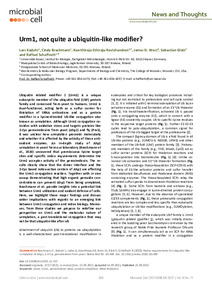| dc.date.accessioned | 2021-12-20T16:33:15Z | |
| dc.date.available | 2021-12-20T16:33:15Z | |
| dc.date.issued | 2021-09-09 | |
| dc.identifier | doi:10.17170/kobra-202112175278 | |
| dc.identifier.uri | http://hdl.handle.net/123456789/13448 | |
| dc.description.sponsorship | Gefördert durch den Publikationsfonds der Universität Kassel | ger |
| dc.language.iso | eng | eng |
| dc.rights | Namensnennung 4.0 International | * |
| dc.rights.uri | http://creativecommons.org/licenses/by/4.0/ | * |
| dc.subject | yeast | eng |
| dc.subject | Urm1 | eng |
| dc.subject | peroxiredoxin Ahp1 | eng |
| dc.subject | protein urmylation | eng |
| dc.subject | tRNA thiolation | eng |
| dc.subject.ddc | 570 | |
| dc.title | Urm1, not quite a ubiquitin-like modifier? | eng |
| dc.type | Aufsatz | |
| dcterms.abstract | Ubiquitin related modifier 1 (Urm1) is a unique eukaryotic member of the ubiquitin-fold (UbF) protein family and conserved from yeast to humans. Urm1 is dual-functional, acting both as a sulfur carrier for thiolation of tRNA anticodons and as a protein modifier in a lysine-directed Ub-like conjugation also known as urmylation. Although Urm1 conjugation coincides with oxidative stress and targets proteins like 2-Cys peroxiredoxins from yeast (Ahp1) and fly (Prx5), it was unclear how urmylation proceeds molecularly and whether it is affected by the activity of these antioxidant enzymes. An in-depth study of Ahp1 urmylation in yeast from our laboratory (Brachmann et al., 2020) uncovered that promiscuous lysine target sites and specific redox requirements determine the Urm1 acceptor activity of the peroxiredoxin. The results clearly show that the dimer interface and the 2-Cys based redox-active centers of Ahp1 are affecting the Urm1 conjugation reaction. Together with in vivo assays demonstrating that high organic peroxide concentrations can prevent Ahp1 from being urmylated, Brachmann et al. provide insights into a potential link between Urm1 utilization and oxidant defense of cells. Here, we highlight these major findings and discuss wider implications with regards to an emerging link between Urm1 conjugation and redox biology. Moreover, from these studies we propose to redefine our perspective on Urm1 and the molecular nature of urmylation, a post-translational conjugation that may not be that ubiquitin-like after all. | eng |
| dcterms.accessRights | open access | |
| dcterms.creator | Kaduhr, Lars | |
| dcterms.creator | Brachmann, Cindy | |
| dcterms.creator | Ethiraju Ravichandran, Keerthiraju | |
| dcterms.creator | West, James D. | |
| dcterms.creator | Glatt, Sebastian | |
| dcterms.creator | Schaffrath, Raffael | |
| dc.relation.doi | doi:10.15698/mic2021.11.763 | |
| dc.subject.swd | Saccharomyces cerevisiae | ger |
| dc.subject.swd | Ubiquitin-ähnliche Proteine | ger |
| dc.subject.swd | Peroxiredoxin | ger |
| dc.subject.swd | Transfer-RNS | ger |
| dc.type.version | publishedVersion | |
| dcterms.source.identifier | eissn:2311-2638 | |
| dcterms.source.issue | No. 11 | |
| dcterms.source.journal | Microbial Cell | eng |
| dcterms.source.pageinfo | 256-261 | |
| dcterms.source.volume | Volume 8 | |
| kup.iskup | false | |


